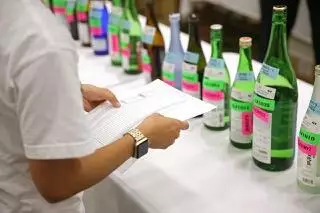The 2024 U.S. National Sake Appraisal, organized by Kokusai Sake Kai, marks its 24th anniversary this year, establishing itself as a significant player in the global sake landscape. First launched in 2001, the appraisal showcases the artistry of sake production not only for connoisseurs but also for an expanding audience of sake enthusiasts in the United States and beyond. This year’s competition assessed a staggering 587 sake entries from renowned brewing regions of Japan and select breweries in the United States, reinforcing the event’s international stature.
Sake, a traditional Japanese rice wine, has seen a rising popularity wave globally, particularly in the United States. This burgeoning interest stems from a blend of cultural curiosity and culinary exploration. The Appraisal aims to enhance public understanding of sake’s nuances, which include its complex flavors and innovative brewing methods. As Naoko DeCosta, a representative of the Appraisal, explains, the goal is not just to judge but to elevate awareness through live tastings that present these fine sakes in their prime condition.
With events held in notable locations like Honolulu and New York City, sake lovers encounter flavors and brands that may not yet be available for retail, giving them a unique preview of Japan’s finest offerings. The infusion of new audiences fosters a cultural exchange that highlights not only the beverage itself but also the deep-rooted traditions behind it.
While the competition primarily celebrates Japanese breweries, it does not exclude brewing talents from North America and other locations. The appraisal received diverse entries from countries like Mexico and Australia in years past. This global participation emphasizes the versatility of sake and may have wider implications for the international brewing community. It posits a question of how traditional practices can shape and influence modern brewing styles in different regions.
With sake imports hitting impressive figures—679,000 liters just in August 2024—the ripple effects from the Appraisal’s judgments will likely resonate within the industry as domestic production begins to flourish in the U.S. The increased volume reflects a changing consumer landscape, where traditional clichés around sake are being replaced by a more diverse understanding of its place in the culinary world.
The rigorous judging framework is another critical aspect of the appraisal, grounded in procedures established by the Japan National Research Institute of Brewing, which oversees Japan’s own national sake appraisal. Composed of an elite panel of judges—eight from Japan and three from North America—the process is deeply rooted in both tradition and expertise. This diverse judging panel not only brings a rich understanding of sake’s historical context but also incorporates fresh perspectives on production techniques and flavor profiles from abroad.
Such a systematic approach not only lends credibility to the awards given but also ensures that participants are recognized based on clear, quality-focused standards. As excellence in brewing is continually redefined, the judgments made can shape industry trends and consumer preferences.
The award winners of this year’s U.S. National Sake Appraisal have certainly set a benchmark for excellence. Highlights include the Grand Prix accolade going to Kid “Muryozan Junmai Daiginjo Seimaibuai 35” from Heiwa Shuzo, showcasing the pinnacle of modern sake craftsmanship. Other standout performances include Zaku and Yuki no Matsushima brands, further illustrating the depth of talent across Japan’s sake breweries.
Notably, the Emerald Award, given yearly to a brewery that accumulates the most gold and silver awards without previous recognition, signifies an important aspect of the event—acknowledging rising stars in the sake industry. This year’s recipient, Heiwa Shuzo, reflects a commitment to quality and innovation in an evolving market.
As the popularity of sake continues to grow in the U.S., events like the U.S. National Sake Appraisal play a crucial role in nurturing this enthusiasm. They educate consumers, recognize brewery excellence, and ultimately celebrate the cultural significance of sake. The combination of deep-rooted tradition and emerging trends in the brewing landscape points to an exciting future for sake, one where innovation and heritage can coexist and thrive. As we look ahead, the evolving narrative of sake promises to shape not only the beverage industry but the culinary experiences of countless consumers.

